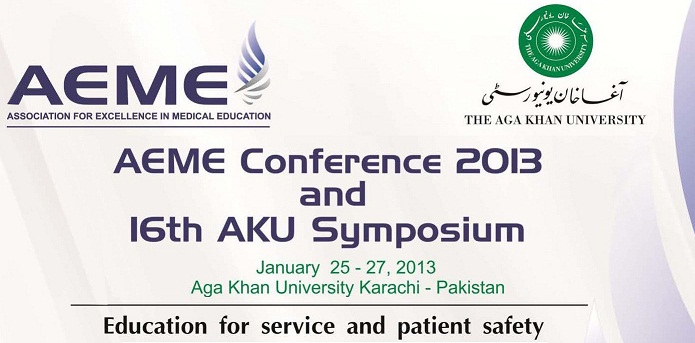Day 1 : Oral Presentations (Theme: Patient Safety)
Malignant mediastinal mass in children: a single institution experience from a developing country
Location
Lecture Hall 2
Start Date
26-1-2013 3:30 PM
Abstract
Background: Malignant mediastinal mass in children represent a potentially serious and life-threatening cardio-respiratory emergency that requires early recognition, prompt assessment of risk factors and careful management in collaboration with a multidisciplinary team in order to reduce morbidity and mortality. The aim of this study was to determine the clinical spectrum and management outcomes of these high risk patients in a developing country.
Methods: We retrospectively reviewed the medical records of all cases of mediastinal masses in children diagnosed and treated over a 5-year period (2007-2011) to determine the pattern of presentation, histopathological diagnosis, radiologic findings and management outcomes at the Aga Khan University and Hospital, Karachi, Pakistan.
Results: A total of 37 patients of mediastinal masses were identified, and malignancy were found in 32 (86%) cases. Most of these were hematologic cancers (n=31; 97%). The median age at diagnosis was 8.8 years. According to their origins, lymphoma (72%) was the most common diagnosis, out of Hodgkin’s and non-Hodgkin’s lymphoma was found in 41% and 31% cases. Leukemia was identified in 25% cases all of whom had T-cell leukemia. Common tumors of anterior, middle and posterior location were acute lymphoblastic leukemia, lymphoma and neuroblastoma, respectively. Eight (25%) patients were asymptomatic. Nonspecific symptoms such as fever (81%), cough (47%) and dyspnea (37%) constituted the most commonly presenting complaints. Lymphadenopathy (69%), visceromegaly (44%), airway compression or deviation (59%), superior vena caval compression (19%), pleural effusion (53%) and pericardial effusion (22%) were the important clinical and radiological findings. All patients received chemo reduction (i.e. steroids ) with or without surgical interventions. Twenty two patients underwent surgical procedures (complete/partial resection of mass), local lymph node biopsy was performed in 5 cases and CT or ultrasound-guided biopsy was done in 2 patients. Twenty seven (84.4%) patients were admitted in pediatric intensive care unit for supportive care and assisted ventilation was required in 20 (62.5%) patients. The mean length of hospital stay was 9.3 (SD + 6) days. None of our patients died due to complications related to mediastinal mass or diagnostic procedure.
Conclusions: Although mortality rate was reduced significantly with refinements in the management protocols, a high index of suspicion and comprehensive multidisciplinary approach is crucial to improve the morbidity.
Key words: mediastinal mass; children; lymphoma; leukemia
Malignant mediastinal mass in children: a single institution experience from a developing country
Lecture Hall 2
Background: Malignant mediastinal mass in children represent a potentially serious and life-threatening cardio-respiratory emergency that requires early recognition, prompt assessment of risk factors and careful management in collaboration with a multidisciplinary team in order to reduce morbidity and mortality. The aim of this study was to determine the clinical spectrum and management outcomes of these high risk patients in a developing country.
Methods: We retrospectively reviewed the medical records of all cases of mediastinal masses in children diagnosed and treated over a 5-year period (2007-2011) to determine the pattern of presentation, histopathological diagnosis, radiologic findings and management outcomes at the Aga Khan University and Hospital, Karachi, Pakistan.
Results: A total of 37 patients of mediastinal masses were identified, and malignancy were found in 32 (86%) cases. Most of these were hematologic cancers (n=31; 97%). The median age at diagnosis was 8.8 years. According to their origins, lymphoma (72%) was the most common diagnosis, out of Hodgkin’s and non-Hodgkin’s lymphoma was found in 41% and 31% cases. Leukemia was identified in 25% cases all of whom had T-cell leukemia. Common tumors of anterior, middle and posterior location were acute lymphoblastic leukemia, lymphoma and neuroblastoma, respectively. Eight (25%) patients were asymptomatic. Nonspecific symptoms such as fever (81%), cough (47%) and dyspnea (37%) constituted the most commonly presenting complaints. Lymphadenopathy (69%), visceromegaly (44%), airway compression or deviation (59%), superior vena caval compression (19%), pleural effusion (53%) and pericardial effusion (22%) were the important clinical and radiological findings. All patients received chemo reduction (i.e. steroids ) with or without surgical interventions. Twenty two patients underwent surgical procedures (complete/partial resection of mass), local lymph node biopsy was performed in 5 cases and CT or ultrasound-guided biopsy was done in 2 patients. Twenty seven (84.4%) patients were admitted in pediatric intensive care unit for supportive care and assisted ventilation was required in 20 (62.5%) patients. The mean length of hospital stay was 9.3 (SD + 6) days. None of our patients died due to complications related to mediastinal mass or diagnostic procedure.
Conclusions: Although mortality rate was reduced significantly with refinements in the management protocols, a high index of suspicion and comprehensive multidisciplinary approach is crucial to improve the morbidity.
Key words: mediastinal mass; children; lymphoma; leukemia

